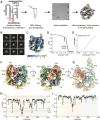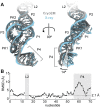A generalizable scaffold-based approach for structure determination of RNAs by cryo-EM
- PMID: 37791881
- PMCID: PMC10639074
- DOI: 10.1093/nar/gkad784
A generalizable scaffold-based approach for structure determination of RNAs by cryo-EM
Abstract
Single-particle cryo-electron microscopy (cryo-EM) can reveal the structures of large and often dynamic molecules, but smaller biomolecules (≤50 kDa) remain challenging targets due to their intrinsic low signal to noise ratio. Methods to help resolve small proteins have been applied but development of similar approaches to aid in structural determination of small, structured RNA elements have lagged. Here, we present a scaffold-based approach that we used to recover maps of sub-25 kDa RNA domains to 4.5-5.0 Å. While lacking the detail of true high-resolution maps, these maps are suitable for model building and preliminary structure determination. We demonstrate this method helped faithfully recover the structure of several RNA elements of known structure, and that it promises to be generalized to other RNAs without disturbing their native fold. This approach may streamline the sample preparation process and reduce the optimization required for data collection. This first-generation scaffold approach provides a robust system to aid in RNA structure determination by cryo-EM and lays the groundwork for further scaffold optimization to achieve higher resolution.
© The Author(s) 2023. Published by Oxford University Press on behalf of Nucleic Acids Research.
Figures






Update of
-
A Generalizable Scaffold-Based Approach for Structure Determination of RNAs by Cryo-EM.bioRxiv [Preprint]. 2023 Jul 6:2023.07.06.547879. doi: 10.1101/2023.07.06.547879. bioRxiv. 2023. Update in: Nucleic Acids Res. 2023 Nov 10;51(20):e100. doi: 10.1093/nar/gkad784. PMID: 37461535 Free PMC article. Updated. Preprint.

